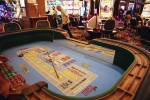Book traces how women changed the game in Vegas
During World War II and in the years after, Las Vegas became a pretty good place for women looking for work. Thanks to rapid growth in the hotel-casino industry, the valley boasted a larger proportion of women in the labor force than did the United States as a whole for decades during the postwar era.
Joanne Goodwin, a history professor and director of the Women’s Research Institute of Nevada at UNLV, explores this period in her recently published book, “Changing the Game: Women at Work in Las Vegas, 1940-1990” (University of Nevada Press, $27.95).
At the core of Goodwin’s book are oral histories of 11 women who worked in the hotel, gaming or entertainment industries here between 1940 and 1990 in positions including casino owner, production show dancer and back-of-the-house employee.
To give the women’s first-person stories context, Goodwin also surveys Las Vegas’ economic, labor and social history to examine how labor trends here — for example, unionization, the influx of women into the labor force, sex and racial desegregation, and the challenges of balancing work with family — foreshadowed trends in U.S. postwar labor history.
The result is fascinating as both a resource for academics and as a good read for anyone interested in Las Vegas’ history.
“What I tried to do is set (the women’s stories) in the context of American women’s labor history,” Goodwin explains. “And it’s my contention that we have a lot to learn about women’s labor history, and about women’s history in general after World War II, by looking at the experience of the women in Las Vegas.”
The valley’s growth during the postwar boom years attracted men and women alike.
Into the ’60s, “the kind of jobs a woman could get here would be similar to the jobs they’d get in Omaha,” she says. “They’d be secretaries, they’d be typists, they’d be clerks, they’d be maids. And the rare exception to that would be when you look at entertainers.”
Many Las Vegas histories tend to focus mostly on the city’s financiers and hotel magnates, Goodwin says, but many people helped keep those operations afloat.
“We wanted to look at those people,” she says, “and in particular the women workers.”
The 11 women who make up the book’s backbone are pioneering casino owners Sarann Preddy and Claudine Williams; dancers Gail McQuary, Janet Kravenko and D.D. Cotton; Bernice Jaeger, a hotel-casino assistant manager; Lucille Bryant, a housekeeper and uniform room supervisor; Carol Gerardi, a craps dealer and floor supervisor; Florence McClure, a hotel executive administrator and community activist; Culinary Union organizer Hattie Canty; and Ffolliott “Fluff” LeCoque, longtime company manager for “Jubilee!”
“The point that I try to draw out throughout the oral histories is that after 1960, the landscape really began to change in terms of workers’ rights, because before then we’re dealing with a segregated workforce by sex and by race.
“And even under those conditions, women from a variety of workplaces said, ‘Yeah, there were jobs out there’ and they paid better than back home.”
Research began in the mid-’90s, Goodwin says, when she and graduate students began arranging to take oral histories. Conducting interviews was an honor, Goodwin says, and in a few cases, intimidating.
Take, for instance, Claudine Williams, whom Goodwin was able to interview before the latter’s death in 2009 at age 88.
“I was nervous about the interview, not because of how she treated me, because she was fabulous and welcoming and generous with her time,” Goodwin says. “But, my God, Claudine Williams owned casinos for decades and is an icon in the community.”
Goodwin says she didn’t see the broader applicability of Las Vegas women’s stories until gathering the oral histories.
“And, then,” she says, “I saw a wealth of comparisons, and there were really some trends that were happening here that historians were not talking about.”
Historians do talk about labor’s important role in organizing workers’ conditions, she says, and that is covered some in her book for the service workers.
But through such women as Preddy and Williams, Goodwin could explore how women could become, and succeed as, business owners at a time when “we didn’t think about women having the opportunity to become business owners, generally.”
By the ’60s and ’70s, research already was showing that a number of women here opened their own businesses, whether real estate, insurance or some kind of service, because it gave them economic autonomy, Goodwin says.
“So I’m beginning to see that as a strategy some women used to get around the legal barriers to advancement,” she says.
The women’s lessons still are relevant, Goodwin adds.
“Like today, the most frequent question that comes up among men students as well as women is, ‘How do you balance demands of work and family?’
“Well, that was a no-brainer for these women. It wasn’t a decision, ‘Do I have a profession, or am I a housewife?’ … The question for them was: ‘How do I do both?’ And they did do both. That was a reality for them because they had children at home and they needed to be in the workforce, and they figured out how to do that.”
Ultimately, Goodwin would like readers to understand the complexity of women’s experiences here in Las Vegas and understand the advancement of women’s rights in the country, using Las Vegas women’s experiences as pieces of a larger whole.
“First of all, let’s put women in the picture of Las Vegas,” she says, and in a way more realistic and more diverse than the way working women in Vegas often are thought of.
“Showgirls and dancers are extremely important,” Goodwin says. “But, my God, there are thousands of other things women have done here, and this is just a part of it, so let’s squeeze that in.
“(And) let’s understand — and this is probably more from a historian’s point of view — how did we get to where we are today? How did women have the opportunities in the workforce that they have today? It didn’t just happen. People worked at it for a long time, and some of the stories (in the book) draw that theme.”
MORE FROM SOUTHERN NEVADA
Other recently published books that were written by Southern Nevada authors or that deal in topics of interest to Southern Nevadans include:
■ “Christmas in Nevada” by former state treasurer and Nevada assemblywoman Patricia D. Cafferata (University of Nevada Press, $26.95) contains stories about how Nevadans have celebrated Christmas from 1858 to today, told by such notable Nevadans as Robert Laxalt and former governors Bob List and Richard Bryan and featuring locales ranging from mining camps to downtown Las Vegas.
■ “The Main Event: Boxing in Nevada from the Mining Camps to the Las Vegas Strip” by Richard O. Davies (University of Nevada Press, $29.95) examines the evolution of boxing in Nevada from its bare-knuckle days to Las Vegas’ enshrinement as a premier international prize fight venue.
■ “Blood Aces: The Wild Ride of Benny Binion, The Texas Gangster Who Created Vegas Poker” by Doug J. Swanson (Viking, $27.95) chronicles the life and times of Benny Binion, from his days in Texas to his tenure as one of Las Vegas’ most powerful casino owners.
■ “The Moneymaker Effect: The Inside Story of the Tournament that Forever Changed Poker” by Eric Raskin (Huntington Press, $16.95) recalls the story of amateur poker player Chris Moneymaker’s win of the 2003 World Series of Poker Main Event and how it helped to change the game almost overnight.
■ “Reno, Las Vegas, and the Strip: A Tale of Three Cities” by UNLV history professor Eugene P. Moehring (University of Nevada Press, $34.95) explores the development of Reno and Las Vegas, particularly from the ’70s onward, and the divergent paths taken by each, and the importance of the Strip’s development to Southern Nevada’s success.
Contact reporter John Przybys at jprzybys@reviewjournal.com or 702-383-0280.


































